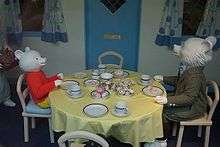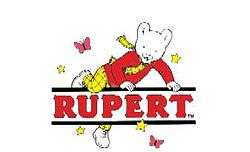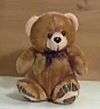Rupert Bear
| Rupert Bear | |
|---|---|
|
Logo for Rupert Bear | |
| Publication information | |
| Publisher | Daily Express |
| Format | Text comics, later balloon comics too. |
| Genre | Adventure comics, Fantasy comics |
| Publication date | 1920–... |
| Main character(s) | Rupert |
| Creative team | |
| Writer(s) |
Mary Tourtel (1920–35) Alfred Bestall (1935–74) Freddie Chaplain (1965–78) James Henderson (1978–1990) Ian Robinson (1990–2002) Stuart Trotter (2008–) |
| Artist(s) |
Mary Tourtel (1920–35) Alfred Bestall (1935–74) Alex Cubie (1975–77) John Harrold (1978–2007) Stuart Trotter (2008–) |
Rupert Bear is a children's comic strip character created by the English artist Mary Tourtel and first appearing in the Daily Express newspaper on 8 November 1920. Rupert's initial purpose was to win sales from the rival Daily Mail and Daily Mirror. In 1935, the mantle of Rupert artist and storyteller was taken over by Alfred Bestall, who was previously an illustrator for Punch and other glossy magazines. Bestall proved to be successful in the field of children's literature and worked on Rupert stories and artwork into his 90s. More recently, various other artists and writers have continued the series.
The comic strip was, and still is, published daily in the Daily Express, with many of these stories later being printed in books, and every year since 1936 a Rupert annual has also been released. Rupert Bear has become a well-known character in children's culture in the United Kingdom, and the success of the Rupert stories has led to the creation of several television series based on the character. The character also has a large fan following, with such groups as The Followers of Rupert.
Characters and story
Rupert is a bear who lives with his parents in a house in Nutwood, a fictional idyllic English village. He is drawn wearing a red jumper/sweater and bright yellow checked trousers, with matching yellow scarf. Originally depicted as a brown bear, his colour soon changed to white to save on printing costs,[1] though he remained brown on the covers of the annuals.
Most of the other characters in the series are also anthropomorphic animals (animals with humanoid forms). They are all scaled to be about the same size as Rupert, regardless of species. Rupert's animal friends are usually referred to as his "chums" or "pals". Aside from his best friend Bill Badger, some of the most enduring pals are an elephant (Edward Trunk), a mouse (Willie), Pong-Ping the Pekingese, Algy Pug (who actually pre-dates Rupert),[2] Podgy Pig, Bingo the Brainy Pup, Freddie and Ferdy Fox, and Ming the dragon. The kindly Wise Old Goat also lives in Nutwood, and helps Rupert in some of his adventures. One of the most unusual and evocative characters is Raggety, a woodland troll-creature made from twigs, who is often very grumpy and annoying. In the 2006 television revival of the series, Raggety has been transformed into a friendly elf with broken English.
There are also a few human characters in the stories, such as the Professor (who lives in a castle with his servant), Tiger Lily (a Chinese girl), her father "the Conjuror", and several less frequently occurring characters such as Sailor Sam, Captain Binnacle and Rollo, the Gypsy boy. There is also a recurring Merboy.
The series often features fantastic and magical adventures in faraway lands. Each story begins in Nutwood, where Rupert usually sets out on a small errand for his mother or to visit a friend, which then develops into an adventure to an exotic place such as King Frost's Castle, the Kingdom of the Birds, underground, or to the bottom of the sea. Sometimes one of the Professor's inventions opens the door to one of Rupert's adventures. At the end of the story Rupert returns to Nutwood, where all is safe and well, and where his parents seem perfectly sanguine about his adventures.
Style
Unlike most modern comic strips, Rupert Bear has always been produced in the original form of strip with illustrations accompanying text, aka "text comics", as opposed to text being incorporated into the art in speech bubbles etc.
Bestall developed the classic Rupert story format: the story is told in picture form (generally two panels each day in the newspaper and four panels to a page in the annuals), in simple page-headers, in simple two-line-per-image verse and then as running prose at the foot. Rupert Annuals can therefore be "read" on four levels. He also established the shape and form of the Rupert stories.
History
Rupert's unspectacular debut was in a single panel, the first of 36 episodes of the story "Little Lost Bear" written and drawn by Tourtel.
Bestall expanded the stories and plots of Rupert; and in addition to precise and detailed drawings for the Daily Express panels he also created beautifully crafted illustrations in the Rupert Annuals. Bestall drew the Rupert stories for the Daily Express until 1965; and continued to illustrate the covers for the annuals until his retirement in 1973. Much of the landscape in Rupert is inspired by the Vale of Clwyd in North Wales (the Professor's castle is based on Ruthin Castle), the Sussex Weald and East Devon. Bestall's successor was Alex Cubie. Cubie created Rupert annual artwork between 1974 and 1977. His images are recognisable from the thicker black outlines around the characters and the use of more vibrant colours than Bestall employed. A Rupert Annual is still produced every year and Rupert appears each day in the Daily Express. In 1978 his new adventures became illustrated by John Harrold; his drawings in the annual were usually coloured by Gina Hart. In 2008 John Harrold was succeeded by Stuart Trotter and a new style of annual (sans serif typeface) with a more modern Rupert to tie-in with the CGI-animation Rupert Bear, Follow the Magic..., began.
The Rupert Annual for 1960 contained a story Rupert and the Diamond Leaf, in which he visits "Coon Island", whose inhabitants are little "Coons".[3] The Coons previously appeared on the cover of The New Rupert: The Daily Express Annual, 1954 and in the interior story Rupert and the Castaway.[4] The first appearance was in the 1946 soft cover summer special Rupert on Coon Island.
Rupert appeared in Paul McCartney's 1984 music video "We All Stand Together"; McCartney also made an animated video starring Rupert called Rupert and the Frog Song.

Tourtel's home was in Canterbury in Kent, and the Rupert Bear Museum, part of the Museum of Canterbury, has collections that cover much of the history of Rupert and his friends, as well as Tourtel and other illustrators. The museum is geared toward families and those interested in the general history of Rupert.
On 31 October 2005, UK Media Group Entertainment Rights (which was later bought by Boomerang Media and then DreamWorks Animation) purchased a majority interest in the Rupert Bear character from the Daily Express. There are plans for a film, books, Limited Edition Prints and DVDs that will see Rupert joined by new friends in addition to established characters.
Books
Rupert Bear Annuals
Every year since 1936, a Rupert Bear annual has been released, even during the years of World War II, during a paper shortage.
- #1–38 = Alfred Bestall
- #39–42 = Alex Cubie
- #43–72 = John Harrold
- #73–76 = Stuart Trotter
|
Rupert Little Bear Library
All of these books were written and illustrated by Mary Tourtel and originally published from 1928–1936, by Sampson Low. There were 46 books in the original series.
- Rupert and the Enchanted Princess (1928)
- Rupert and the Black Dwarf (1928)
- Rupert and his Pet Monkey (1928)
- Rupert and his Friend Margot (and Rupert, Margot and the Fairies) (1928)
- Rupert in the Mystery of Woody (1929)
- Further Adventures of Rupert and his Friend Margot (and Rupert and the Stolen Apples) (1929)
- Rupert and the Three Roberts (1929)
- Rupert, the Knight and the Lady (and Rupert and the Wise Goat's Birthday Cake) (1929)
- Rupert and the Circus Clown (1929)
- Rupert and the Magic Hat (1929)
- Rupert and the Little Prince (1930)
- Rupert and King Pippin (1930)
- Rupert and the Wilful Princess (1930)
- Rupert's Mysterious Plight (1930)
- Rupert in Trouble Again (and Rupert and the Fancy Dress Party) (1930)
- Rupert and the Wooden Soldiers (and Rupert's Christmas Adventure) (1930)
- Rupert and the Old Man and the Sea (1931)
- Rupert and Algy at Hawthorn Farm (1931)
- Rupert and the Magic Whistle (1931)
- Rupert Gets Stolen (1931)
- Rupert and the Puss in Boots (1931)
- Rupert and the Christmas Tree Fairies (and Rupert and Bill Badger's Picnic Party) (1931)
- Rupert and His Pet Monkey Again (and Beppo Back With Rupert) (1932)
- Rupert and the Rubber Wolf (1932)
- Rupert's Latest Adventure (1932)
- Rupert and Humpty Dumpty (1932)
- Rupert's Holiday Adventure (and Rupert's Message to Father Christmas and Rupert's New Year's Eve Party) (1932)
- Rupert's Christmas Tree (and Rupert's Picnic Party) (1932)
- Rupert, the Witch and Tabitha (1933)
- Rupert Goes Hiking (1933)
- Rupert and Willy Wispe (1933)
- Rupert Margot and the Bandits (and Rupert at School) (1933)
- Rupert and the Magic Toyman (1933)
- Rupert and Bill Keep Shop (and Rupert's Christmas Thrills) (1933)
- Rupert and Algernon (and Rupert and the White Dove) (1934)
- Rupert and Beppo Again (1934)
- Rupert and Dapple (1934)
- Rupert and Bill's Aeroplane Adventure (1934)
- Rupert and the Magician's Umbrella (1934)
- Rupert and Bill and the Pirates (1935)
- Rupert at the Seaside (and Rupert and Bingo) (1935)
- Rupert Gets Captured (and Rupert and the Snow Babe's Christmas Adventures) (1935)
- Rupert, the Manikin and the Black Knight (1935)
- Rupert and the Greedy Princess (1935)
- Rupert and Bill's Seaside Holiday (and Rupert and the Twins' Birthday Cake) (1936)
- Rupert and Edward and the Circus (and Rupert and the Snowman) (1936)
Some of the titles were later published for the Woolworth's retail chain, with only 18 of the original titles. However, the titles and numbers for this series did not relate to the earlier published series.[5]
- Rupert and the Magic Toy Man
- Rupert at the Seaside
- Rupert and the Enchanted Princess
- Rupert and Edward at the Circus
- Rupert and Bill and the Pirates
- Rupert and the Magician's Umbrella
- Rupert in the Wood of Mystery
- Rupert and Prince Humpty Dumpty
- Rupert and the Magic Whistle
- Rupert and Dapple
- Rupert and the Greedy Princess
- Rupert and the Wonderful Boots
- Rupert and Willy Wispe
- Rupert and Bill Keep Shop
- Rupert and the Magic Hat
- Rupert's Holiday Adventure
- Rupert Goes Hiking
- Rupert, the Manikin and the Dark Knight
Brainwaves Limited
Brainwaves Limited of Basingstoke, Hampshire, produced a series of Rupert storybooks in 1991 (no author or artist credited):
- Rupert and the Golden Acorn
- Rupert and the Elfin Bell
- Rupert and the Popweed
- Rupert and the Iceberg
In addition, they published other Rupert series:
- Rupert Mini Board Books
- Rupert Hookbooks
- Rupert Storytime Books
- Rupert Shaped Board Books
- Rupert Flap Books
Television series
The Adventures of Rupert Bear (1967–1977)
Rupert first appeared on television in an ITC series produced for the ITV network that ran for over 100 ten-minute episodes. The characters were all puppets, although the opening sequence featured a toy Rupert bear sitting in a live-action child's bedroom. Rupert's friends and flying chariot appeared straight from the Daily Express pages, although he was joined by some new friends including a sprite called Willy Wisp.
One of the most memorable elements of the series was the catchy theme song, written by Len Beadle (aka Frank Weston) and Ron Roker, sung by Jackie Lee, which reached number 14 in the UK charts in 1971. The song included the erroneous lyric "Rupert the Bear", even though Rupert has never had the definite article in his name.
A short film directed by Geoff Dunbar based on ideas/music/songs by Paul McCartney was made in 1985, titled "Rupert and the Frog Song". It follows Rupert as he explores the country one night and finds a special gathering of frogs. The film contains a song titled "We All Stand Together", written by McCartney and arranged by the Beatles' producer George Martin. The band Wings performs with McCartney.
Rupert (1985–1988)
Rupert returned to television in 1985 to the BBC, in the form of 36 short five-minute stories.[6] These were cartoons, but were not animated; instead each episode consisted of a series of still illustrations and narration. The sole narrator was Ray Brooks,.[7] The short title music is credited to Brave New World. In the US these shorts aired on the Disney Channel as part of its Lunchbox program. A selection of the episodes have been released on a number of VHS videos, no official DVD releases are so far available as of 2014.
Rupert (1991-1997)
In 1991, Rupert Bear got his own 2D cartoon animated television series set in a small town in the late 1950s/early-to-mid 1960s, with 65 episodes over 5 seasons (13 per season) produced by Nelvana (Canada), Ellipse (France) and TVS Television South for the first season (13 episodes), with Scottish TV taking over control from season 2 when TVS Television South lost its ITV franchise. The show greatly followed the style and tone Bestall established in the Rupert newspaper series, with many of the stories being almost direct adaptations of his or others' panel stories from the Daily Express.
It was broadcast in syndication on YTV in Canada. In the United States the show first aired on Nickelodeon before moving to CBS;[8] repeats of the series came to Qubo's digital service in January 2007. The show was broadcast in the UK on CITV. In Australia, the show was broadcast on the ABC and on TV2 in New Zealand as part of the Jason Gunn Show. The series has been re-aired in the UK on the satellite and cable channel Tiny Pop. As of 2009 the show also airs daily on Qubo channel, although only the latter 26 episodes are currently being shown.
Rupert Bear, Follow The Magic... (2006-2008)
In 2006 a new Rupert Bear stop-motion-animated television series was produced, skewing almost entirely towards small children. Notable changes to the characters are that Rupert wears trainers/sneakers and his fur has a slight tan; Pong Ping has become a girl who uses magic and had her name reversed; Raggety, who rarely appeared before, became a friendly tree elf; Ming became a baby dragon and Ping Pong's pet; Edward no longer has tusks, his trunk has been straightened and he wears an orange T-shirt and brown shorts; and one of the fox twins (Ferdie) has been changed into a girl named Freda. There are new characters like Miranda the mermaid; but characters like Podgy Pig, his self-obsessed sister Rosalie and the timid Willie Mouse make no appearances.
Rupert Bear, Follow The Magic ... was broadcast on Five from 8 November to 1 February 2008. Fifty-two ten-minute episodes were broadcast and subsequently repeated.
Video games
The British 1980s video games publisher, Quicksilva adapted Rupert Bear for the Commodore 64 and ZX Spectrum 8-bit computers. This company published two game installments, the 1985 Rupert and the Toymaker's Party and the 1986 Rupert and The Ice Castle.
References
- ↑ The Independent (6 November 2006). "Rupert Bear gets 21st Century makeover".
- ↑ George Perry and Alfred Bestall, Rupert, A bear's Life, Pavilion Books: 1985, p. 18
- ↑ Larratt, Shannon (22 May 2007). ""Rupert visits Coon Island" (!)". Shannon Larratt is Zentastic. Retrieved 25 January 2011.
- ↑ "Rupert the Bear: Rupert and the Castaway". Retrieved 25 January 2011.
- ↑ "Rupert Little Bear Library". Rupertannuals.com. Archived from the original on 13 March 2012. Retrieved 11 June 2016.
- ↑ "BFI | Film & TV Database | RUPERT". Ftvdb.bfi.org.uk. Retrieved 2013-05-04.
- ↑ "Rupert [VHS]: Tara Strong, Gerrit Schmidt-Foß: Movies & TV". Amazon.com. 2000-07-19. Retrieved 2013-05-04.
- ↑ Josef Adalian (1998-12-13). "Nick vet CBS-bound as nets alter kidvid skeds". Variety. Retrieved 2013-05-04.
Sources
- Daily Express, 1 November 2005
External links
- Rupert (1991) at the Internet Movie Database
- The Followers of Rupert
- The History Behind Rupert Bear
- Rupert And The Frog Song
- Rupert Little Bear Library
- Rupert Bear Museum – Canterbury
- Rupert and the Toymaker's Party – Mobygames.com
- Rupert and the Ice Castle – Gamespot.com

